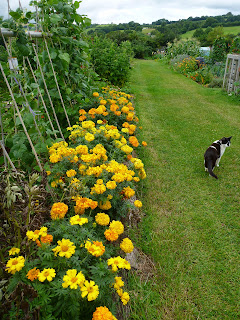Companion Planting
A few of us have been discussing aspects of companion planting recently. Companion planting simply means growing certain plants together which benefit each other.
Companion plants assist each other by either attracting beneficial insects, repelling pests or providing nutrients, shade, or support. Generally the plants have to be grown very close to each other for this to work.
Many people will have heard of the carrots/onions combination. The scent each gives off confuses the predators of the other and is said to help prevent damage by carrot root fly and onion fly respectively. According to researchers, you need to grow four times more onions than carrots to have the desired effect.
Another famous combination, known as the Three Sisters, comprises sweetcorn, climbing beans and squash planted together. The beans climb the sweetcorn, and the squash provides shade at the roots of the taller crops. You also get three crops in the space of one. I've never tried all three as I think it must make harvesting quite difficult, but the principles can be used in other ways.
There is a great deal of information available about which plants go, or don't go, with others (and it doesn't help that some studies offer conflicting advice). Also, some vegetables are only beneficial when left to flower, which might be useful to farmers but less so for allotmenteers.
Apart from vegetables however, there are other plants - flowers and herbs - which make great companion plants, and the benefits of which are more clearly recognised. Here are just a few:
It's easy to make a start and I would suggest the few simple ideas below:
Companion planting is part of a biological system of pest control - so remember, if you are using plants to attract beneficial insects to your plot, not to kill them by spraying your crops!
It does take a lot of planning to companion-plant your whole plot, and I still get it wrong at times. But if you're interested then there are some quite helpful charts available - or do come and talk to me.
Companion plants assist each other by either attracting beneficial insects, repelling pests or providing nutrients, shade, or support. Generally the plants have to be grown very close to each other for this to work.
Many people will have heard of the carrots/onions combination. The scent each gives off confuses the predators of the other and is said to help prevent damage by carrot root fly and onion fly respectively. According to researchers, you need to grow four times more onions than carrots to have the desired effect.
Another famous combination, known as the Three Sisters, comprises sweetcorn, climbing beans and squash planted together. The beans climb the sweetcorn, and the squash provides shade at the roots of the taller crops. You also get three crops in the space of one. I've never tried all three as I think it must make harvesting quite difficult, but the principles can be used in other ways.
There is a great deal of information available about which plants go, or don't go, with others (and it doesn't help that some studies offer conflicting advice). Also, some vegetables are only beneficial when left to flower, which might be useful to farmers but less so for allotmenteers.
Apart from vegetables however, there are other plants - flowers and herbs - which make great companion plants, and the benefits of which are more clearly recognised. Here are just a few:
- Nasturtiums and Borage act as trap crops by attracting blackfly away from your vegetables.
- Lavender, Rosemary and other aromatic herbs release chemicals that deter pests.
- Yarrow attracts beneficial insects such as hoverflies which eat aphids.
- Marigolds are great all around your plot as they repel many insects with their scent.
It's easy to make a start and I would suggest the few simple ideas below:
- Mix it up. Aim to create lots of little micro-systems in your beds rather than large areas of one type of plant.
- Diversity. Grow herbs and flowers amongst your vegetables (potager style) to encourage bees and other beneficial insects.
- Ground cover. Bare earth is bad - grow sprawling plants such as squashes beneath other crops to provide vital shade to roots. Fill spaces between slow growing crops with a quick catch crop. Lettuces don't mind some shade so grow them beneath tall plants.
Companion planting is part of a biological system of pest control - so remember, if you are using plants to attract beneficial insects to your plot, not to kill them by spraying your crops!
It does take a lot of planning to companion-plant your whole plot, and I still get it wrong at times. But if you're interested then there are some quite helpful charts available - or do come and talk to me.
Submitted by Jane, plot 9

Comments
Post a Comment